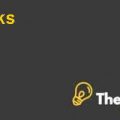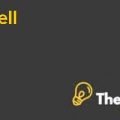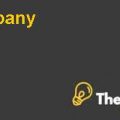Problem Diagnosis
The owner of the Anandam Manufacturing Company had approached its bank in July 2015 for the additional financing so that he could grow the garment manufacturing firm and achieve its objectives. Expansion is the objective of the owner and the owner was confident about the future prospects of the company as the profitability and the sales revenue of the company had increased by four times during the past three years. He had a long discussion with the bank manager where he shared the long development history of his business and the future growth opportunities within the textile and the garment market of India.
The industry was highly competitive and the competition was also growing but he believed that his company was performing strongly against the competitive industry. The loan officer has been now asked to process the loan and make a final decision as soon as possible. A range of analysis techniques such as common size analysis, cash flow analysis, trend analysis and ratio analysis would be conducted in this case study to make a final decision for Anandam Manufacturing Company.
Case Analysis
The objective of our analysis is to conduct a detailed financial statement analysis for Anandam Manufacturing Company in order to ensure that the company is financing sound and it has the borrowing capacity and capability to repay the loans. The operational performance of the company would also be analyzed to determine the strengths of the firm and identify its weaknesses. We first begin with the analysis of the cash flow statement for the years 2013 and 2014.
Cash Flow Statement Analysis
Analysis of the cash flows of the business is the most important aspect of the performance of the firm. A positive increase in cash is shown from the operating activities and most of the cash comes from the income statement activities. The interest expense was also moved to finance section and the addition of the depreciation as non-cash charge helped to boost the cash flow.
The inventory has increased, thus decreasing the operating cash flow and this shows that Anandam has adopted a more conservative working capital strategy for increasing the level of the inventory on the balance sheet. The cash flow from investing activities shows that in the last few years less cash has been invested for buying new PPE and this has a positive impact on cash. However, this had increased in 2014
Finally, the net cash flow from financing activities shows a positive trend, especially in the last one year. The equity issue and the debt issue for the company has increased and this is from where the financing has been generated by the company. The share issue has increased the cash balance by $ 400 in each of the two years The case does not provide any evidence of dividends. If we sum up all the above analysis, then we can conclude that the cash position of the company is quite strong at present and it has enough cash to cover its obligations.
The cash flow statement for the company is shown in the table below for 2013 and 2014:
| CASH FLOW STATEMENT | ||
| 2013–14 | 2014–15 | |
| Cash Flows from Operating Activities | ||
| Net Income | $672 | $840 |
| Add Expenses Not Requiring Cash: | ||
| Depreciation | 400 | 660 |
| Amortization of Goodwill | 0 | 0 |
| Other | 0 | 0 |
| Other Adjustments: | ||
| Subtract Increase in Accounts Receivable | -1200 | -600 |
| Add Increase in Current Liabilities | 1468 | 1052 |
| Subtract Decrease in Accounts Payable | 0 | 0 |
| Subtract Increase in Inventory | -1180 | -750 |
| Other | 0 | 0 |
| Net Cash from Operating Activities | $160 | $1,202 |
| Cash Flows from Investing Activities | ||
| Purchase of New Equipment | -900 | -2460 |
| Other | 0 | 0 |
| Net Cash Used for Investing Activities | -$900 | -$2,460 |
| Cash Flows from Financing Activities | ||
| Proceeds from share issue | $400 | $400 |
| Proceeds from LTD | 500 | 1264 |
| Other | 0 | 0 |
| Net Cash from Financing Activities | $900 | $1,664 |
| NET INCREASE OR (DECREASE) IN THE CASH | $160 | $406 |
| CASH AT THE BEGINNING OF YEAR | 40 | 100 |
| CASH AT THE END OF YEAR | $200 | $506 |
Common Size Statement Analysis
Next, we have prepared the common size financial statements for the company and first we would analyze the vertical financial statements of the company. The vertical analysis shows that majority of the sales, around 90% are derived through credit sales for the company. The cost of sales as a percentage of sales declined for the company however, all the operating expenses such as interest expense, selling, general and admin expense have all increased for the firm. The operating and net profit percentage of the total sales is also following a negative trend which is quite alarming for the management of the company. This is not a positive sign about the profitability of the company.
The vertical balance sheet shows that cash as a percentage of the total assets has decreased and similar is the situation with accounts receivables. However, the latter is a positive trend for the company. The inventories are also decreasing as a percentage of total assets and this suggests that the conservative working capital policy is working in the favor of the company. On the other hand, the long term debt has increased as a percentage of total assets for the company and the current liabilities have slightly decreased. The vertical financial statements are shown below:
| VERTICAL INCOME STATEMENT | |||
| 2012–13 | 2013–14 | 2014–15 | |
| Sales | |||
| Cash | 10.00% | 10.00% | 10.00% |
| Credit | 90.00% | 90.00% | 90.00% |
| Total sales | 100.00% | 100.00% | 100.00% |
| Cost of goods sold | 62.00% | 59.00% | 60.00% |
| Gross profit | 38.00% | 41.00% | 40.00% |
| Operating expenses: | 0.00% | 0.00% | 0.00% |
| General, administration, and selling expenses | 4.00% | 9.38% | 12.50% |
| Depreciation | 5.00% | 8.33% | 8.25% |
| Interest expenses (on borrowings) | 3.00% | 3.29% | 4.25% |
| Profit before tax (PBT) | 26.00% | 20.00% | 15.00% |
| Tax @ 30% | 7.80% | 6.00% | 4.50% |
| Profit after tax (PAT) | 18.20% | 14.00% | 10.50% |
| VERTICAL BALANCE SHEET | ||
| 2013–14 | 2014–15 | |
| Assets | ||
| Fixed assets (net of depreciation) | 44.64% | 51.33% |
| Current assets | ||
| Cash and cash equivalents | 1.79% | 1.16% |
| Accounts receivable | 26.79% | 22.94% |
| Inventories | 26.79% | 24.57% |
| Total | 100.00% | 100.00% |
| Equity & Liabilities | ||
| Equity share capital (shares of | ||
| ₹10 each) | 28.57% | 21.84% |
| Reserve & surplus | 18.50% | 20.49% |
| Long-term borrowings | 22.07% | 27.30% |
| Current liabilities | 30.86% | 30.36% |
| Total | 100.00% | 100.00%
|
This is just a sample partial case solution. Please place the order on the website to order your own originally done case solution.









